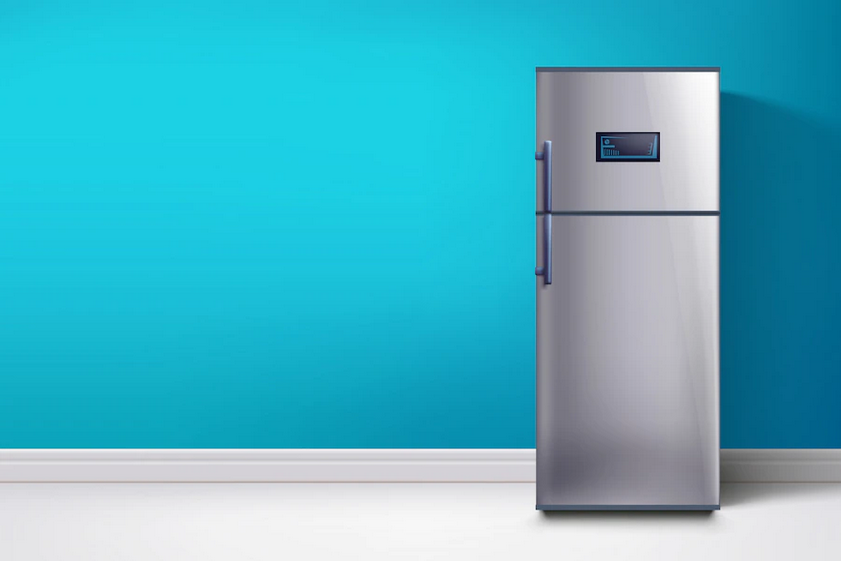There are several basic components of refrigerators. These include the outer cabinet, inner cabinet, insulation between the cabinets, cooling system, refrigerant, fixtures, and controls. The exterior cabinet is made of sheet metal, which is usually purchased in coils and directly fed into the manufacturing process. The interior cabinet is often made of plastic or sheet metal, with fiberglass or poly foam insulation between the cabinets. The cooling system consists of copper and other materials.
Refrigerant
In a refrigerator, the Refrigerant is what allows it to maintain a temperature below the ambient air temperature. It is an artificial process in which energy in the form of heat is transferred from a low-temperature reservoir to a high-temperature reservoir. It can be found in many types of appliances and is used to keep food, drinks, and other items fresh. This article will explain the basic components of a refrigerator and what it does.
All refrigerators use a small amount of refrigerant, which is a liquid that is pumped into a condenser. This liquid then disperses out into the surrounding environment. Modern refrigerators are designed with a single cooling unit, but the workings of various modifications vary. For example, a one-camera refrigerator may contain a recirculated flow of refrigerant, whereas a multi-camera refrigerator might contain only a single camera.
Until the 1970s, refrigerators used a mixture of chlorine, fluorine, and carbon. The chemicals in these gases destroyed the ozone layer and were banned in the US. Fortunately, newer and more efficient versions of these chemicals have been introduced that have lower greenhouse gas emissions. These changes will help reduce power consumption and greenhouse gas emissions. A refrigerator will not use as much power when running as it once did.
A recent study conducted by Penn State University suggests that sound waves may be a better alternative to chemical refrigerants. The researchers were funded by Ben and Jerry’s, a noted environmentally conscious ice cream company. A sub-zero refrigerator, which is based on sound waves instead of chemical refrigerants, is a good model to start looking for. There are many types of refrigerators available today
Components
The refrigeration system of a refrigerator includes a variety of components. The refrigeration tube system is typically made of copper or aluminum. These materials are used for both their thermal transferring abilities and energy efficiency. In modern refrigerators, the tubing may also be made of plastics, which can reduce weight and keep food cold longer. The refrigerator’s exterior is typically made of sheet metal, which is powdered or painted to prevent damage from external elements. In CFC-containing units, the cooling system must be drained of the coolants before they can be reused.
Compressors are important parts of refrigerators. They increase the pressure of the gas inside by reducing its volume. The compressor is classified as hermetic, open, and semi-hermetic, depending on its position. A hermetic compressor is sealed to prevent leakage, while a semi-hermetic compressor is not hermetically sealed. Compressors can also be hermetic or open, based on how they are installed and their location.
A compressor is responsible for increasing and decreasing the pressure of the liquid refrigerant in a refrigerator. This liquid is then sprayed into the evaporator, which is a low-pressure environment where temperature can be changed. Finally, the refrigerator’s thermostat is responsible for controlling the entire process. A thermostat keeps an eye on the refrigerator’s temperature and turns on the compressor when it needs to. Throughout the process, the capillary tube reduces the pressure of the refrigerant and the compressor increases the pressure of the liquid. Once the compressor is turned off, the refrigerant will be cooled again.
Sizes
You’ve probably heard about the different sizes of refrigerators, but do you know how to figure out which one is right for your kitchen? Sizes are measured in cubic feet, and standard refrigerators range from 20 to 25 cubic feet in capacity. They should have an area of 14 to 20 cubic feet, but you can get smaller refrigerators if your kitchen is smaller. The following are some tips to help you determine the size you need.
First, you’ll want to measure the width and depth of the refrigerator that you’re planning to purchase. The width is a standardized measurement in the industry, with most full-sized models being around 30 inches or 33 inches wide. The depth is a bit tricky to calculate, but it’s easy to estimate the amount of space it will take up in a pre-built cabinet or cavity. You’ll want to make sure there is enough room on either side for the refrigerator’s doors to open fully and close easily.
The depth is the distance from the back wall to the front of the counter. You don’t want the refrigerator to be wider than the width of your counter space. Manufacturers recommend allowing two inches behind the refrigerator, one inch on either side and one inch on top. However, these dimensions vary slightly from one brand to the next. To find the right size, subtract the width and depth of the refrigerator from the width of the cabinet’s opening.
The size of a refrigerator is important for many reasons, including its capacity and power usage. Counter-depth refrigerators are usually 28 to 30 inches deep. Counter-depth models are typically larger than standard fridges, but the counter-depth versions are often the most expensive. Counter-depth refrigerators often feature adjustable shelves and are available in smaller sizes. Similarly, bottom-freezer models are often available in smaller sizes. You should also take the height and width into consideration when deciding on the size and capacity.
Colors
When choosing colors for a new refrigerator, consider which color you will use with it. In the past, consumers have been drawn to certain colors for a variety of reasons, including their desire for color or their need to match their kitchen decor. In addition to promoting the gradual replacement of older appliances, colorized models can be attractive and make a good first purchase. If you’re not sure which color you should choose for your refrigerator, ask your local appliance retailer.
While white is a timeless classic, black and grey are also popular colors for refrigerators. They pair well with minimalist, Scandinavian, and Gothic decors. You can also choose grey, steel, and silver appliances. While white is a popular color for refrigerators, silver, and steel appliances are also great choices. Grey and brown appliances are often used in ethnic or modern styles. Brown and warm colors work well in Baroque interiors.
A few decades ago, pastel appliances were a popular option. While pastels were no longer as popular as they were in the 1950s, color appliances continued to be popular in homes and even in office buildings. But consumers were not so quick to replace their Sunshine Yellow fridge. It’s possible that the designers of Frigidaire intended to engineer this style obsolescence into their designs. And while pastel colors may have been popular during that time, pastels are not considered classic today.
You can choose between black stainless steel and white stainless steel. GE, LG, and Samsung have the most extensive range of black stainless steel products. On the other hand, Whirlpool, Frigidaire, and KitchenAid have limited selections in black stainless steel. So, when deciding on the color of your refrigerator, consider your lifestyle. You might just find the perfect color for your kitchen. You can even customize it yourself!
Repairs
A faulty cooling system or cooling is not apparent in a refrigerator? This can be the result of a burned circuit board or a stuck relay. To test a refrigerator for this problem, unplug it and open the back panel. Locate the circuit board. Press the press-on connectors onto the new board. If you suspect a burnt circuit board, check the largest relay. If not, contact a qualified refrigerator repair technician.
To get a good estimate, it’s a good idea to call several companies and get quotes. Compare the estimates provided by each of them to ensure that they are reasonable. If any of them offer a free estimate, make sure to ask about the extra charges that may apply. Lastly, make sure to check whether the repair company offers a warranty. This will protect you from any hidden costs that might arise later. Also, be sure to ask for a written estimate.
When comparing refrigerator repair costs, you should take into account the age of the refrigerator. Older refrigerators are more expensive to repair and may require a more advanced technician. Consumer Reports recommends replacing the refrigerator if the repair costs are more than half of the new price. However, if it’s a simple problem, it might be worth trying to repair the unit yourself. A skilled repair technician will be able to repair it for you at a reasonable cost.
When determining the cost of repairing a refrigerator, it’s important to consider the type of parts and labor that will be needed. Some refrigerators require replacement parts, and these can cost anywhere from $200 to $700. The door seal alone can cost up to $50, a drip tray $40-40, and a drainpipe $10. In addition, if your fridge has a faulty compressor, a professional technician should be able to fix it for you.



